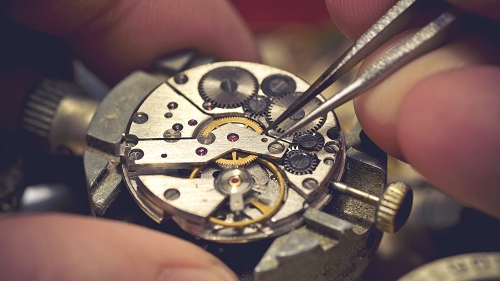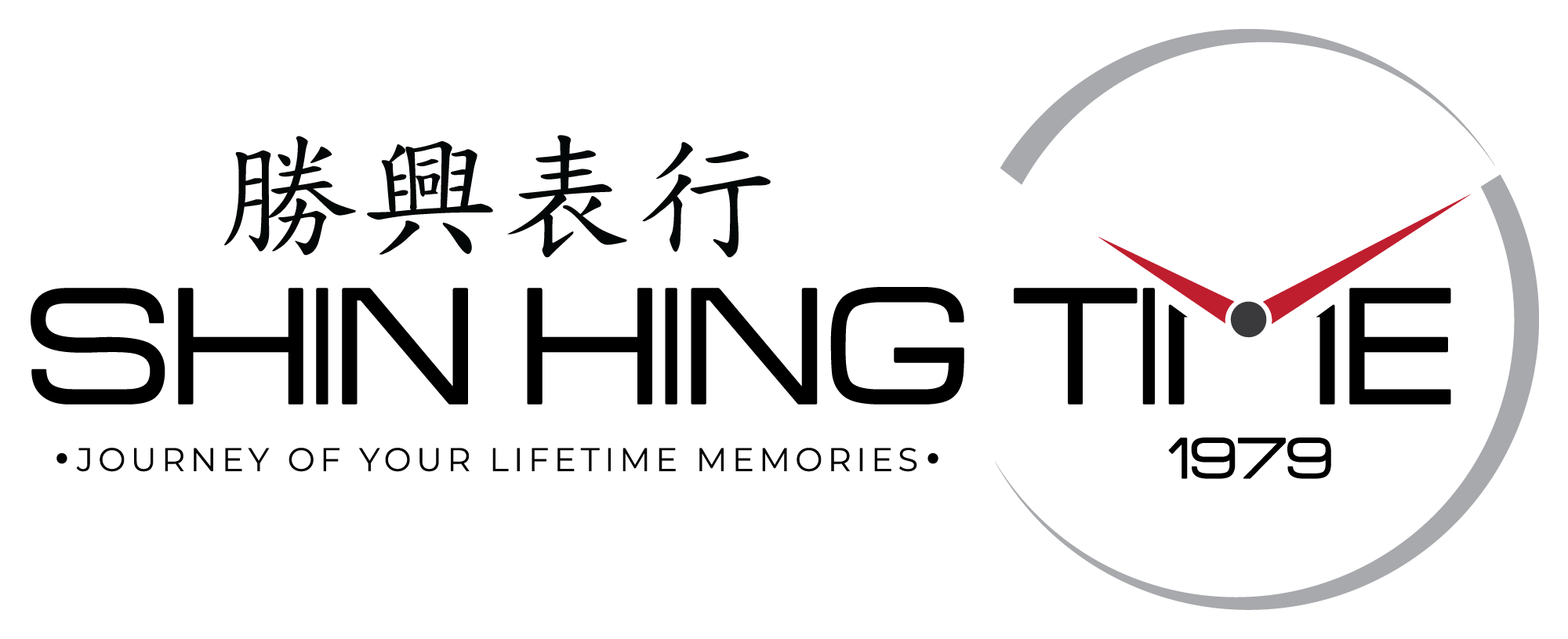SHIN HING TIME understands that a proper education is the foundation for understanding the “complicated” world of fine watches. Even a basic fine watch contains over 100 working parts. These incredibly small parts are all designed to fit together to make your mechanical watch "tick tack".
Even the smallest parts of the watch serve a purpose and help the watch to work continuously over the years. The following list features many of the basic terms relating to the parts of a fine watch:

Watch Glossary
12 or 24 Hour Register
The register, also known as a recorder, is a sub-dial on the face of a chronograph that can record periods of time up to 12 or 24 hours.
30 Minute Register
Similar to the hour register, the 30 minute register is a sub-dial on a chronograph that records periods of time up to 30 minutes.
A
Alarm
A device that sounds a signal at a predetermined time.
Altimeter
A device that determines altitude by responding to changes in barometric pressure.
AM/PM Indicator
Also referred to as a day and night indicator, it allows the wearer to determine the time of day on a 12 hour analog or digital watch.
Analog
A term describing a clock or watch having hour and minute hands rather than using digital liquid crystal display (LCD).
Annual Calendar
Is an accurate yearly calendar that must be adjusted at the end of February. The watch will display the day, date and month, typically including the year. Read about different types of calendar complications.
Aperture
The small window that is either carved or cut into the dial to display various indications, including the date.
ATM (Atmosphere)
A unit of pressure for the standard atmospheric pressure at sea level. One atmosphere is the pressure of 1kg/cm2 and corresponds to 10 meters of depth. An ATM is displayed as a value such as 5ATM.
Automatic Watch
Is a type of mechanical watch. It winds with the movement of the wearer’s wrist by a small weight rotating with the motion. Automatic watches can also be manually wound by turning the crown. Learn more about automatic movements.
B
Band
A ring on your finger, or a group who plays music. When referring to watches, it is referred to as a bracelet or strap; not as a band.
Bar
Another unit of measurement relating to the pressure a watch can withstand. One bar is about equal to the atmospheric pressure at sea level and is approximately 10 meters.
Bezel
A metal (though occasionally ceramic) ring that surrounds the watch crystal. Often bezels rotate on watches (usually on dive watches) and contain a scale for time or other measurements; some remain stationary or do not have a scale and are purely decorative. (Learn more about different kinds of bezels here.)
Bi-Directional Rotating Bezel
The type of bezel used to track elapsed time. They can be turned clockwise or anti-clockwise.
Bracelet
Is the metal version of a band or strap used to keep the watch in position on your wrist. Created using metal links that can be removed for sizing.
C
Calendar
A complication showing the date and the month. It often shows the day of the week and the year depending on the complexity of the movement.
Caliber (Calibre)
The term identifying movements from their architecture, origin, reference and maker. It is part of the movement identifying the position and size of the wheel train.
Case
Container that protects the watch movement from dust, moisture and shocks, often referred to as the body of the watch. It gives the watch as attractive an appearance as possible, subject to fashion and the taste of the public and is created out of different materials and precious metals.
Caseback
The reverse side of the watch case, laying flat on your wrist. Some watches feature an exhibition caseback that is transparent allowing you to see the movement. Casebacks typically carry some engraving noting the name, water resistance and other details.
Chronograph
A chronograph is a watch that does not only indicate the time of the day in hours, minutes and seconds, but is also equipped with an additional mechanism – operated manually by push buttons –which makes possible to measure continuous or discontinuous intervals of time, from a fraction of a second to 12 hours.
Countdown
Time remaining in a predefined period.
Crown
Device with which to wind the watch. Can be a screw down version or pull-out. Crowns are also used to set the time and the calendar.
Crystal
A transparent cover that protects the watch dial. Crystals are made of glass, plastic or synthetic sapphire. Synthetic sapphire is the most expensive to produce, though it is considerably more scratch resistant than either acrylic or glass crystals.Non-reflective coatings on some crystals prevents glare. (See also: Mineral Crystals, Plastic Crystals, Sapphire Crystals)
D
Day/Date Function
A complication showing both the date and the day of the week.
Day/Night Indicator
Typically found in dual time zone watches, see also AM/PM Indicator. A colored band that shows which zone is daytime and which is night time.
Deployant Buckle
A buckle that fastens to the watch strap and opens and fastens using hinged extenders. Invented by Louis Cartier in 1910. A deployant buckle is easier to put on and remove than a tang buckle. Deployant comes from the verb “deployer” which means to unfold. Do not mistakenly refer to it as a “deployment” clasp. This safety feature also ensures the watch won’t drop when putting it on your wrist.
Dial
Indicating the face of the watch. The dial holds various markings to show the hours, minutes and seconds or more depending on the complications of the watch. Dials vary much in shape, decoration, material, etc. The indicators are given by means of numerals, divisions or symbols of various types.
Dive Watch
A dive watch is a water-resistant watch, but not all water-resistant watches are dive watches. True dive watches should meet a specific standard for diving like ISO 6425, which requires the watch to be water-resistant to at least 200 meters, feature a unidirectional rotating bezel and some form of illumination.
Digital
Developed in the 1970s, digital watches use arabic numbers in an LCD display.
Dual Time
Measures both current local time and at least one other time zone. It can be found in a twin dial, extra hand or subdial. Also referred to as world time.
E
Exhibition Caseback
Also can be referred to as a skeleton caseback, this shows off the movement through a second crystal located on the back of the case.
F
Fly-Back Hand
In a split-seconds chronograph, a second center seconds hand that can move while remaining superimposed on the first hand, but can be stopped and brought back to zero together with the first hand as it moves. It can also be stopped and brought back to zero together with the first hand and is useful to aviators.
G
Gasket
A rubber, neoprene or plastic ring used to seal the gaps between the case and the case back, crystal and crown to prevent water or dust from entering the case and damaging the movement inside.
Gold-plating
An electro deposited layer of gold with the thickness is measured in microns. “GP, HGE, GE” or any fraction after a number are stamps indicating gold plate.
GMT Time
Also known as Greenwich Mean Time, it is the international standard of time that the world is set to. Every time zone is set against GMT. In watches, a GMT reference refers to the ability to show dual time zones with a second hour hand, primarily found in a 24-hour mode to determine day from night.
H
Hand
The indicator that moves over the dial to point at the hour, minute or second. Watches generally have three hands to show the hours, minutes and seconds. Hands can have very different shapes: pear, Breguet, sword, skeleton, baton, arrow, etc.
Hand-wound
Referring to a mechanical watch that doesn’t automatically wind. Hand-wound watches are powered by manually turning the crown to wind up the mainspring.
Hour Markers
Arabic numerals, Roman numerals or symbols placed around the dial to mark the hours.
Hybrid Smartwatch
A classically-styled analog watch (usually quartz-powered) that also features digital smart functions like activity tracking and push notifications. (Read our review of one of our favorite hybrid smartwatches here.)
I
Indices/ Index
The markings on the dial of a watch used to represent the hours in place of numerals. In higher-end watches, these are usually “applied,” or attached to the dial, rather than printed on.
J
Jewels
Synthetic rubies (sometimes synthetic sapphires) used as bearings at the heaviest points of wear in a watch movement in order to reduce friction between moving parts and increase a movement’s lifespan. Jewels have a naturally slicker surface than metal — for example, the coefficient of friction between two pieces of steel is about 0.58, while the coefficient of sapphire on steel is about 0.15. Jewels are only used to increase the accuracy of the movement and are not for decoration.
L
Limited Edition
A watch manufactured in a specific amount, typically numbered and available in limited quantities. These watches are highly sought after.
Liquid Crystal Display
Also known as LCD, it is another term for digital watches, showing an arabic numeral display. The liquid is encased between two clear plates and activated by electronic impulses.
Luminous
Luminous (lume) markers and hands are made by applying glow in the dark coating to the indicator. This allows them to illuminate automatically in a darkened environment.
Lugs
The protruding pieces of metal at the top and bottom of a watch case where the strap is attached. The two ends of the lug hold a spring bar, which holds the strap in place.
M
Mechanical Movement
A mechanical movement is powered by a main-spring and works with the balance wheel.Mechanical watches are the most traditional type of watch. They usually consist of about 120-180 individual parts. This is a watch that runs without any electrical source and can consist of manual wind watches or automatic watches.
Meter
The most common unit of measurement when referring to the water resistance of a watch. Relates to how deep a watch is able to go, testing is done in a controlled laboratory.
Mineral Crystal
Heat hardened glass about ten times harder than plastic. Extremely scratch resistant but must be replaced if they do scratch.
Moon Phases
A complication that represents waxing and waning of the moon as it circles the earth. This complication is shown in a window on the watch dial.
Mother of Pearl
Interior shell that is thinly sliced and used as a watch dial. Most are found with a white luster but can be found in gray, blue, pink and salmon tones.
Movement
The fully functioning assembly of all the main timekeeping organs of a watch. Three main movements include mechanical, automatic and quartz.
N
Numerals
Including both Roman (I, II, III, IV, etc) and Arabic (1,2,3,4, etc) numbers to mark the hours around the dial.
P
Perpetual Calendar
A calendar complication capable of showing the day, date and month but often includes the moon phase and year. It takes into account short and long months in addition to the leap year. It is accurate until the year 2100.
Plate
A metal plate that supports the bridges and various parts of the movement.
Polished
Used to make the case and bracelet smooth and brilliant by very fine-grained abrasives or by rubbing with a burnisher.
Power Reserve
Running time in excess of the normal time (24 hours for ordinary watches) between two consecutive windings. In an ordinary watch, the power reserve usually provides for 10 to 16 hours running. Some watches feature a Power Reserve Indicator to alert the wearer of time remaining until the watch stops. Can also be referred to as the Reserve de Marche.
Power Reserve Indicator
A feature of a mechanical watch that shows the remaining power in a watch movement, indicating the length of time until the timepiece will need to be wound again.
Q
Quartz Movement
Quartz watches are battery powered. They can either have hands, like the more traditional mechanical watch, or have a digital display. These watches are much more accurate than even the most expensive manual wind watches. Learn more about the quartz movement and the quartz revolution.
S
Sapphire Crystal
Sapphire crystals are 2-3 times harder than mineral glass and virtually scratch-proof. They are more brittle so are more likely to crack or shatter than mineral. Replacement cost is substantially higher than for mineral crystals.
Screw Back
The back of the case has a thread so that it can be screwed into the case.
Screw Down Crown
A crown that is threaded and tightened when the wearer screws it in. It utilizes a gasket to make the watch water tight.
Second Time Zone Indicator
Found on an additional dial, used to set a separate time zone to be viewed simultaneously as the local time.
Shock Resistant
Used in a watch whose movement is protected against shocks, i.e. fitted with a shock-absorber system. Defined by the US government as the ability to withstand an impact of being dropped onto a wood floor from a height of 3 feet.
Skeleton
Similar to an exhibition case back, a skeleton watch shows off the inner workings of the watch, but does so through a transparent or partially cut-out dial so that the movement can be viewed from the front of the watch.
Small Seconds
A small sub-dial separate from the main hour and minute function that displays the seconds.
Split Seconds Chronograph
A watch that possesses two hands, one of which can be stopped to indicate an intermediate time while the other hand continues to run. (Learn more: Split Seconds Chronograph)
Spring Bar / Spring Pins
Spring loaded pins located between the lugs to attach the bracelet or strap.
Standard Time
The time that is kept locally in each of the time zones when it is not daylight savings time.
Stem
The shaft that connects to the movement’s winding mechanism. The crown is fitted on the opposite end.
Stop Watch
An instrument that only measures intervals of time and does not indicate the time of day. Another word for a chronograph.
Strap
A strip or band of leather or rubber that holds the watch to the wrist. It must be non-metal to be considered a strap; a metal version is referred to as a bracelet.
Sub-Dial
A small dial placed inside the main dial on a watch’s dial. Watches can have as many as four sub-dials (auxiliary dials). They give information not provided by the main watch dial such as chronographs, alarm, dual time zone, and calendar.
Sun/Moon Indicator
An additional complication found on watches, it is a wheel that is partially visible through the dial indicating the sun and moon in a 24-hour period.
Sweeping Seconds Hand
A second hand that is mounted in the center of the dial, instead of a sub-dial, and “sweeps” the entire dial of the watch.
Swiss Made
A watch can only be considered to be Swiss made if, (1) its movement is Swiss; (2) its movement is cased up in Switzerland and (3) the manufacturer carries out the final inspection in Switzerland.
T
Tachymeter
A tachymeter (also known as tachometer) measures the speed at which the wearer has traveled over the measured distance found commonly on a chronograph. The wearer starts the chronograph when passing the starting point and stops it when passing the finish. The wearer can then read the speed in units per hour off the tachymeter scale.
Time Zones
Time zones refer to the twenty-four regions or divisions of the globe. Our time zone here in Minnesota will be indicated by either Chicago or Mexico City. (Learn more: Multiple Time Zone Watches)
U
Uni-Directional Rotating Bezel
Typically found on divers’ watches. The bezel only rotates in a counterclockwise direction and is designed to prevent a diver from running out of air by over estimating remaining air supply.
V
Vibration
The movement of an oscillating part of the watch, limited by two extreme positions. Generally 5 or 6 vibrations per second, 18,000 or 21,600 per hour, but can also be a higher frequency with as many as seven or ten vibrations, 25,200 or 36,000 per hour. See also: Frequency.
W
Water-Resistant
The case, crown, push button and glass of a water-resistant watch are made in such a way that no dust or water can penetrate. Watches undergo in-house tests in a laboratory under controlled conditions. Learn more about water resistance markings.
Waterproof
A prohibited term used when describing the water resistance of a watch. No watch is 100% waterproof.
Winding Stem
Another word used for the crown. A button found on the side of the case used to wind the mainspring.
World Time Complication
A dial that contains up to 24 different time zones, found usually on the outer edge of a dial. The time zones are represented by using the names of major cities.




